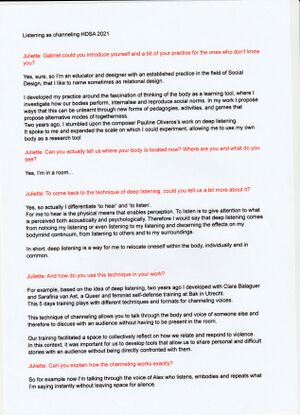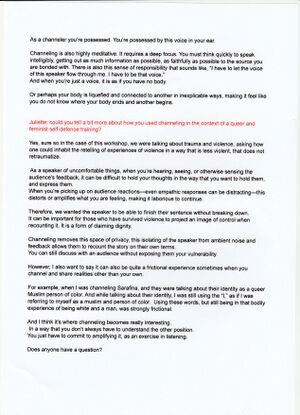Channeling Listeners
I attended the H&D Summer Academy in 2021. Having participated in summer schools before, I am well acquainted with the sense of uncertainty that the first day of a summer school can bring. A group of people from different places is thrown together in an unfamiliar environment. There is a sense of chaos in which its order is unknown. From time to time, relations form. People you didn't know, who you just met a few hours ago, become people you see every day. An ecology unfolds from within. It is an event in which perceptions are built and dismantled simultaneously. Processes within processes.
I will write about a specific experience I had at the H&D Summer Academy. On the final evening, after we had cooked and eaten together, we went to watch a performance. We entered a large open space, which was situated inside a large warehouse, the NDSM Loods. In the space an exhibition was installed. We sat down on the floor. In front of us were two chairs, on which two people sat: Juliette Lizotte, from H&D, and Alex Harris, who I had not met before. Juliette interviewed Alex. She asked him questions and a conversation unfolded between them. I remember that the exchange was interesting, but that I could not entirely grasp all the details.
After the talk, another person appeared, Gabriel Fontana. It quickly became clear that we had been fooled. We were told that Alex, the interviewee, didn’t answer the questions himself but had repeated what Gabriel had said through a small device in his ear. This action is also known as “channeling.” The illusion it created was so powerful that I did not pick up on the performance aspect. After it was revealed to us, we asked them both questions and were invited to experience this magical way of communicating ourselves. In small groups, we took turns playing different roles: the absent speaker, present responders (channels), and interviewers. The line of communication between the absent speakers and the channels took place via mobile phones and headphones.
At one point, I became the absent speaker. I walked through the exhibition while talking on the phone, alternating between looking at the artworks and thinking about my answers. I went about it intuitively and heard my spoken words repeated on the other end of the line. I remember that hearing my words repeated by another person had a calming effect on me. It created a rhythm that flowed through me. The fact that I was in a different place made it easier for me to speak. The look in the eyes of the person I was conversing with was eliminated, our body languages shielded from view. All that mattered was the exchange of words and the freedom I had to move about in the room. Hearing my repeated words felt like affirmation. The other person echoed my perspective—our words intersected. Additionally, it gave me the opportunity to think about my chosen words again. Hearing what was said on the other end of the line caused me to reflect on whether I had communicated what I wanted. The experience caused me to think, and afterwards, questions came to my mind. Could the act of channeling help someone who struggles with speech? Could this way of communicating with and through another function as a tool for healing? Can it make the inexpressible expressible? How can we become a respectful channel for a person with whom we don’t share a language?[1]
It is not just that this method can offer relief to the absent speaker, it can also help the channel as well. The channel is, so to speak, an extension of the absent person. Becoming a united vessel puts the channel in a important position. The words uttered by the speaker are not simply repeated by the channel, the channel must develop a sensibility for their words, and deliver the words as the absent speaker intended. Repetition isn’t just repetition. It becomes an act of interpreting, listening, breathing, stepping back, caring, and carrying.
The delivery of another’s words might confront the channel with ideas they may not have thought of before; thoughts now verbalized, uttered from one's own mouth. Another grammar flows through their body. This merging of two distinct bodies breaks with the normative notion of an isolated body. To be a channel for an-other means to welcome “the stranger within,”[2] which can confuse one’s own language and perhaps contribute to its (un)learning. It can also produce ambivalence. What if the speaker responds with something you would never say yourself? The happening itself is also ambivalent. Bodies are woven together regardless of their differences.[3]
I believe that communicating through a channel can be fruitful if done thoughtfully. Becoming the voice for someone else is a lesson in how to listen to others. Listening includes subjectivity—and as such, differs from hearing, as Pauline Oliveros has noted. Hearing means perceiving, while listening means paying attention to what is perceived.[4] By paying attention to what one hears, relations emerge and infrastructures are shaped. In a sense, the speaker is a channel, too. One needs to listen to oneself in order to speak. The words uttered might not even be the exact translation of one’s thoughts and feelings, which perhaps is anyhow an impossible act. Verbalized words are yesterday's thoughts. Through channeling, what is spoken is not final. Words and speech is situational, material and always in direct dialogue with its surroundings. When we listen to another, we recognize more than just the uttered words, but also that which is unexpressed—other words, feelings, and thoughts. It requires us to open ourselves to the unspoken, we need to become “orifices”[5] in order to let the other in. Becoming a channel changes us by gifting us with another perspective. We attune ourselves to the other.
- Sandy Richter (Nuremberg, 1995) studied communication design in Hamburg. Currently she is engaging with topics of love, chaos and touch to explore how to enable healing relations to (in)visible materialities.

